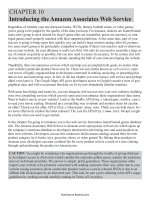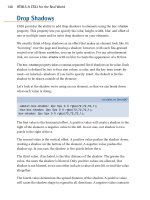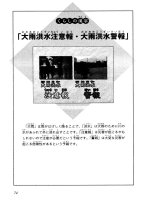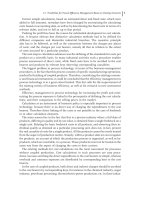Ozren Ocic Oil Refineries in the 21st CenturyOil phần 6 pps
Bạn đang xem bản rút gọn của tài liệu. Xem và tải ngay bản đầy đủ của tài liệu tại đây (236.22 KB, 15 trang )
Specific net consumption of process and thermal energy, in this case, is obtained
when the energy value of the steam delivered is deducted from the energy value of the
steam consumed, i.e.:
ð135 À 50ÞTJ
94 314 t of feedstock
¼ 901:2MJ=t
If specific net energy consumption of a typical plant is compared with the target
standard, the following conclusion can be drawn:
1. Specific electric energy consumption is close to the target standard.
2. Specific net consumption of process and thermal energy (fuel and steam) on
a typical plant amounts to 1 578.8 MJ/t, thus exceeding the target standard
(1 257 MJ/t) by 26%.
3. Total specific net energy consumption is 1 626.7 MJ/t, which is 25 % higher than
the target standard (1 300 MJ/t). Compared with the net energy consumption target
standard, a typical plant has an efficiency/inefficiency index of 125.
Tab. 29 Financial presentation of energy consumption and money
savings on a typical bitumen blowing unit (in US$)
Specific gross energy consumption
Energy
carriers
Q’ty of feedstock
(crude oil)
US$
94 314 t
Fuel oil 94 314 t (677.6 MJ/t  0.00305 US$/MJ) = 194 917
Medium-pressure steam 94 314 t (1 435.2 MJ/t  0.0032308 US$/MJ) = 437 319
Sources of heat 94 314 t (2 112.8 MJ/t  0.003173 US$/MJ) = 632 236
Electric energy 94 314 t (47.9 MJ/t  0.0167 US$/MJ) = 75 445
Energy carriers 94 314 t (2 160.7 MJ/t  0.003473 US$/MJ) = 707 681
Specific net energy consumption
US$/t
Fuel oil (677.6 MJ/t  0.00305 US$/MJ) = 2.06668
Medium-pressure steam (901.2 MJ/t  0.0032308 US$/MJ) = 2.911597
Sources of heat (1 578.8 MJ/t  0.003154 US$/MJ) = 4.978277
Electric energy (47.9 MJ/t  0.0167 US$/MJ) = 0.79993
Energy carriers (1 626.7 MJ/t  0.003553 US$/MJ) = 5.778207
Sources of heat:
Internal net energy consumption (1 578.8 MJ/t  0.003154 US$/MJ) = 4.98
Target net energy consumption (1 257 MJ/t  0.003154 US$/MJ) = 3.96
Difference: 1.02
Energy carriers:
Internal net energy consumption (1 626.7 MJ/t  0.003553 US$/MJ) = 5.78
Target net energy consumption (1 300 MJ/t  0.003553 US$/MJ) = 4.62
Difference: 1.16
4.4 Instruments for Determining Energy and Processing Efficiency of Bitumen Blowing Unit 6767
This increased consumption of process and thermal energy on a typical plant is
caused by different factors, the most important being:
– non-economical combustion in the process heater,
– inefficient utilization of the flue gases heat in the process heater and in the heater
for burning the waste gases,
– inefficient utilization of produced bitumen heat,
– preheating of compressed air by steam,
– inefficient utilization of MP steam for pump drive by means of steam turbines, and
– unstable preheating of combustion air before it enters the process heater.
4.4.5
Determining Refinery Product Cost Prices
On a bitumen blowing unit, determining the cost prices is simple because, in this
case, the feedstock is vacuum residue from the vacuum-distillation unit, and the pro-
duct is bitumen. This means that the cost price of this product is determined by adding
the costs of this unit to the cost price of feedstock (Tab. 30).
Tab. 30 Determining the cost prices of refinery products on bitumen
blowing unit
Item no.Elements for calculation Q’ty in
tonnes
Total
in US$
Cost price
US$/t
Bitumen
12 3 4 5 6
1 Q’ty in tonnes 180 141.8 180 141.8
2 (%) from equivalent numbers
3 (%) from q’ty
4 Vacuum residue 180 142 30 593 490 169.83
5 Feedstock 180 142 30 593 490 169.83 30 593 490
6 Chemicals – –
7 Water – –
8 Steam 1 075 755 1 075 755
9 Electric power 516 832 516 832
10 Fuel 139 383 139 383
11 Depreciation 30 841 30 841
12 Other production costs 652 410 652 410
13 Wages 1 547 987 1 547 987
14 Taxes 680 921 680 921
15 Unit management costs 1 182 612 1 182 612
16 Laboratory and Maintenance costs 167 465 167 465
17 Common services costs 166 121 166 121
18 Total costs 36 753 816 36 753 816
19 Cost price in US$/t 204.03 204.03
4 Instruments for Determining Energy and Processing Efficiency of an Oil Refinery68
4.5
Instruments for Determining Energy and Processing Efficiency of Catalytic
Reforming Unit
4.5.1
Technological Characteristics of the Process
Catalytic reforming is the process of converting the low-value straight-run gasoline
from a crude unit into high-value engine fuel or into components for jet-fuel blending,
by means of catalyst in the presence of hydrogen. This process is also used for gen-
erating the products from which benzene, toluene, xylene and heavy aromatics are
obtained.
This unit consists of reactors, auxiliary columns, heat exchangers, which use the
heat of mass flows and the heaters in which heating the feedstock and intermediary
products takes place.
Heated feedstock (the straight-run gasoline) goes to the first reactor where the che-
mical reactions begin by means of which the high-quality products are obtained.
The product leaves the first reactor at a temperature of 330–340 8C, and goes to the
separator through a heat exchanger and cooler. In the separator, the gas fraction is
separated from heavy fractions. Part of the gas from the separator is returned as a
reflux into the feedstock line.
The heavy fractions, after having been treated in the auxiliary column (separating the
wet gas and light gasoline) go into the reactor section that consists of process heaters
and reactors.
In the reactor section, the reactor feedstock is mixed with recirculated gas rich in
hydrogen, then heated in heat exchangers and heaters and passed through the process
reactor. In this way, high-octane gasoline can be achieved.
The heaters are placed between the reactors in order to compensate the heat that is
used for endothermic reactions. After the heat exchanger, the product from the reactor
is cooled and directed into the separator, where the liquid phase is separated from the
gas rich in hydrogen. The greater part of the gas is returned to the reactors, while the
smaller part goes into the fuel-gas system and the flare in order to maintain pressure in
the system.
Liquid phase goes into the stabilizer. The temperatures of the processes are
350–500 8C, pressures 10–25 bar and the obtained products are as follows:
– hydrogen,
– fuel gas,
– wet gas,
– light gasoline,
– light platformate, and
– platformate.
The technological characteristics of the process are shown in Fig. 10.
4.5 Instruments for Determining Energy and Processing Efficiency of Catalytic Reforming Unit 6969
4.5.2
Energy Characteristics of the Process
On a typical catalytic reforming process the feedstock is preheated in heat exchan-
gers by means of product stream of this process, before entering the process heater.
In the process heaters, fuel gas is used as a fuel.
Medium-pressure steam (MpS) is used to drive the ejector, to heat the bottom of the
auxiliary column and to drive spare systems of the main pump. One part of medium-
pressure steam (MpS) is generated in this unit, by means of the boiler–utilizer of flue
gases heat, and the other is provided from external sources.
Electric power is used to drive pumps, fan (air cooling) and other equipment and
auxiliary facilities as well.
The main energy characteristics of the catalytic reforming process are given in Fig.
11, where all the important ways of supplying the energy required for the process are
shown as well. Each option is a possible solution for such a process.
For the purpose of catalytic reforming process, a block energy-flows scheme and
Senky’s diagram for the energy balance, are shown in Scheme 6 and Diagram 5.
The given energy consumption values apply to the yearly production volume of
380 605 t straight-run gasoline and a specific product slate.
The difference between the gross and net consumption appears only in medium-
pressure steam (MpS), due to the internal generation in the unit itself. Gross con-
sumption totals 40 000 t or 119 TJ, net consumption is 30 000 t or 89 TJ and internal
generation is 10 000 t or 30 TJ.
Fig. 10 Technological characteristics of catalytic reforming process
4 Instruments for Determining Energy and Processing Efficiency of an Oil Refinery70
Fig. 11 Energy characteristics of catalytic reforming process
Scheme 6 Energy flows of catalytic reforming process
4.5 Instruments for Determining Energy and Processing Efficiency of Catalytic Reforming Unit 7171
4.5.3
Determining the Steam Cost Price
The cost prices of medium-pressure steam (MpS) generated and used in the catalytic
reforming process, as well as the average cost price of medium-pressure steam, are
given in Tab. 31.
Tab. 31 shows that the largest portion of medium-pressure steam (MpS) needed for
this unit, 30 000 t or 89 TJ, is provided from the refinery power plant at the cost price of
9.66 US$/t, and the difference of 10 000 t or 30 TJ is generated in this unit at the cost
price of 0.45 US$/t, so the average cost price of medium-pressure steam used in this
unit is 7.36 US$/t.
The basic explanation for such a low cost price of medium-pressure steam (MpS)
generated on this unit (0.45 US$/t) lies in the fact that the steam is obtained as a by-
product, by utilizing the heat of the flue gases in the boiler-utilizer thus offsetting the
consumption of engine fuel (fuel oil or fuel gas) which shares in calculating cost prices
of the steam generated in refinery power plant, with about 80 %.
4.5.4
Energy Efficiency of the Process
In relation to the medium-pressure steam (MpS) specific consumption, the feed-
stock to be processed is as follows:
Diagram 5 Senky’s diagram of energy flows of catalytic
reforming process, in TJ/y
4 Instruments for Determining Energy and Processing Efficiency of an Oil Refinery72
gross:
105 kg of steam
t of feedstock
or: 312:6
MJ
t of feedstock
net:
79 kg of steam
t of feedstock
or: 233:8
MJ
t of feedstock
Tab. 32 presents the target standard of net energy consumption and specific gross
and net energy consumption, and Tab. 33 shows the financial presentation of energy
consumption and money savings of 548 100 US$/y (380 605t x 1.44US$/t) that can be
achieved by eliminating the differences between the target standard (average energy
Tab. 31 Cost prices of medium-pressure steam (MpS)
Item
no.
Elements for calculation Medium-pressure steam generation
(MpS)
MpS for
internal
consumption
Annual
q’ty in t
Cost price
US$/t
Total in
US$
12 3 4 5 6
1 MP steam provided from Refinery
Power Plant
30 000 9.66 289 800 289 800
2 MP steam generation 10 000 0.45 4 525 4 525
2.1 Demineralized water 10 000 0.165 1 650
2.2 Depreciation 2 400
2.3 Current and investment maintenance 285
2.4 Insurance premium for equipment 190
3 Total (1+2) 40 000 7.36 294 325 294 325
4 Quantity in t 40 000
5 Cost price of MpS in US$/t 7.36
Tab. 32 Target standard of net energy consumption and specific
energy consumption on a typical catalytic reforming unit (quantity of
energy per one tonne of feedstock)
Energy carriers Target standard
of net energy
consumption
Specific energy consumption in the plant
Specific gross energy
consumption
Specific net energy
consumption
(kg/t)
1
(kWh/t)
(MJ/t) (kg/t)
1
(kWh/t)
(MJ/t)
(MJ/t) (kWh/t)
per unit total per unit total
Fuel
Fuel gas * – 57.1 2 845.4 2 845.4 57.1 2 845.4 2 845.4
Heat carriers
MP steam * – 150 312.6 312.6 79 233.8 233.8
Sources of heat 2 656 – – 3 158.0 – – 3 079.2
Electric energy 144 40.0 42.5
1
153.0 153 42.5
1
153 153
Energy carriers 2 800 –––3311– –3232.2
4.5 Instruments for Determining Energy and Processing Efficiency of Catalytic Reforming Unit 7373
consumption of Western European refineries) and specific gross and net energy con-
sumption of this refinery unit.
By comparing net energy consumption of a typical plant with the target standard, the
following conclusions can be drawn:
1. Specific electric energy consumption is close to the target standard.
2. Specific net consumption of process and thermal energy (fuel and steam) of 3079.2
MJ/t exceeds the target standard (2656 MJ/t) by 16 %.
3. Total specific net energy consumption is 3232.2 MJ/t, i.e. 15 % higher than the
target standard (2800 MJ/t). Compared with the target standard of net energy con-
sumption, a typical plant has an efficiency/inefficiency index of 115.
Increased consumption of process and thermal energy on a typical plant is caused
by different factors, the most important being:
– non-economical combustion in the process heater,
– inefficient feedstock preheating system,
Tab. 33 Financial presentation of energy consumption and money
savings on a typical catalytic reforming unit (in US$)
Specific gross energy consumption
Energy carriers Q’ty of
feedstock
US$
380 605 t
Fuel gas 380 605 t (2 845.4 MJ/t  0.0027 US$/MJ) = 2 924 028
Medium-pressure steam 380 605 t (312.6 MJ/t  0.002462 US$/MJ) = 292 922
Sources of heat 380 605 t (3 158.0 MJ/t  0.002676 US$/MJ) = 3 216 950
Electric energy 380 605 t (153 MJ/t  0.0167 US$/MJ) = 972 484
Energy carriers 380 605 t (3 311 MJ/t  0.00332446 US$/MJ) = 4 189 434
Specific net energy consumption
US$/t
Fuel gas (2 845.4 MJ/t  0.0027 US$/MJ) = 7.682580
Medium-pressure steam (233.8 MJ/t  0.002462 US$/MJ) = 0.575656
Sources of heat (3 079.2 MJ/t  0.0026819 US$/MJ) = 8.258236
Electric energy (153 MJ/t  0.0167 US$/MJ) = 2.555100
Energy carriers (3 232.2 MJ/t  0.0033455 US$/MJ) = 10.813336
Sources of heat:
Internal net energy consumption (3 079.2 MJ/t  0.0026819 US$/MJ) = 8.26
Target net energy consumption (2 656 MJ/t  0.0026819 US$/MJ) = 7.12
Difference: 1.14
Energy carriers:
Internal net energy consumption (3 232.2 MJ/t  0.0033455 US$/MJ) = 10.81
Target net energy consumption (2 800 MJ/t  0.0033455 US$/MJ) = 9.37
Difference: 1.44
4 Instruments for Determining Energy and Processing Efficiency of an Oil Refinery74
– inefficient application of the heat from process heater,
– no preheating of air before entering process heaters.
4.5.5
Determining the Refinery Product Cost Prices
The feedstock for catalytic reforming process is 70–175 8C gasoline that is obtained
on the crude unit.
It is necessary to perform desulfurization of this gasoline, by chemical reactions, in
order to increase the octane number. In this way this gasoline can be used as a com-
ponent in motor gasoline blending.
The heavy platformate that is blended into gasoline as a high-octane component, is
mostly the product of this unit, but also the light gasoline that presents the feedstock
for gas concentration unit and light platformate that presents the feedstock for the
aromatics extraction unit.
The cost prices of semi-products generated on the catalytic reforming unit, are de-
termined by equivalent numbers obtained by means of the density method, although
equivalent numbers can be determined by the following methods as well:
– thermal value method, and
– average production cost method.
By analysing the results obtained by means of the different calculation bases for
determining equivalent numbers, significant differences in the cost prices of oil pro-
ducts generated in this unit can be seen. These differences are presented in Tab. 34
and Graphics 13 and 14.
Besides the significant differences in cost prices for the same refinery product,
which depend on the calculating bases for determining the equivalent numbers,
for example, the cost price of heavy platformate is from 268.34 US$/t (the base for
determining the equivalent numbers is product density) to 234.60 US$/t (the base
Tab. 34 Cost prices of semi-products on catalytic reforming unit
in US$/t (per calculating bases)
Item
no.
Semi-products Base for determining the equivalent number
for calculating the cost prices
Product Density
Method
Thermal Value
Method
Average Production
Cost Method
12 3 4 5
1 Dry gas 138.23 245.93 238.31
2 Wet gas 138.23 245.93 238.31
3 Light gasoline 205.89 243.66 238.31
4 Light platformate 231.91 241.40 238.31
5 Heavy platformate 268.34 234.60 238.31
4.5 Instruments for Determining Energy and Processing Efficiency of Catalytic Reforming Unit 7575
for determining the equivalent numbers is product thermal value), the different
ranges in oil-product cost prices can also be noted even with the same calculating base.
For example, when product density is the base for determining the equivalent num-
bers, the cost prices range from 138.23 US$/t (dry and wet gas) to 268.34 US$/t (heavy
platformate).
The stated examples of the calculating bases effects on determining the equivalent
numbers do not present all the dilemmas that experts dealing with process-industry
Graphic 13 Cost prices of semi-products on catalytic reforming
unit, per products (in US$/t)
Graphic 14 Cost prices of semi-products on catalytic reforming
unit, per calculating bases (in US$/t)
4 Instruments for Determining Energy and Processing Efficiency of an Oil Refinery76
calculations can face. The effects of the choice of reference derivatives (heavy platfor-
mate whose density is 0.825 g/cm
3
, light platformate whose density is 0.712 g/cm
3
and
light gasoline whose density is 0.630 g/cm
3
) on determining the equivalent numbers,
in the case of using the same calculating base for determining the equivalent numbers
(density method) are shown in Tab. 35.
It can be seen that the differences appearing in this case are smaller than those
appearing in the previous example of determining the equivalent numbers by diffe-
rent calculating bases (density, thermal value and quantity of products) [19].
The results obtained by using the different reference derivatives, but the same cal-
culating base, i.e. density method, are shown in Tab. 35 and Graphics 15 and 16)
The cost prices of semi-products generated on the catalytic reforming unit, were
calculated in the following manner, by means of the product density method:
Tab. 35 Cost prices of semi-products on catalytic reforming unit
in US$/t (per reference products)
Item
no.
Semi-products Reference products
Heavy platformate Light platformate Light gasoline
12 3 4 5
1 Dry gas 138.23 138.23 137.17
2 Wet gas 138.23 138.23 137.17
3 Light gasoline 205.89 205.52 206.65
4 Light platformate 231.91 232.44 232.46
5 Heavy platformate 268.34 268.33 268.19
Graphic 15 Cost prices of semi-products on catalytic reforming unit, per different
reference products (in US$/t)
4.5 Instruments for Determining Energy and Processing Efficiency of Catalytic Reforming Unit 7777
*
Proportional costs are distributed to semi-products generated in this unit according
to the percentages obtained from equivalent numbers by means of the density
method and reference product, i.e. heavy platformate whose density is 0.825 g/
cm
3
(Tab. 36, Column 11 and Tab. 37, Line 2).
*
Fixed costs are distributed to semi-products according to the percentages obtained
from the quantity (Tab. 37, Line 3).
*
For determining the feedstock value (Tab. 37, Line 7), it is necessary to previously
determine the cost prices of crude distillation semi-products, considering that
70–175
o
C gasoline, which presents the feedstock, is generated in this unit.
By using the mentioned methodology for distributing the proportional and fixed
costs of this unit to the bearers of costs, i.e. to the products obtained in this unit,
the following cost prices of semi-products are established:
Semi-products Cost prices in US$/t
12
Dry gas 138.23
Wet gas 138.23
Light gasoline 205.89
Light platformate 231.91
Heavy platformate 268.34
Graphic 16 Cost prices of semi-products on catalytic reforming unit,
per same reference products (in US$/t)
4 Instruments for Determining Energy and Processing Efficiency of an Oil Refinery78
Tab. 36 Determining the equivalent numbers for distributing the proportional costs on catalytic reforming unit
Item
no.
Oil products Quantity
in tonnes
Q’ty from
1 tonne
Density
g/cm
3
Equivalent
numbers
Condition
units
Cost of
1 condition
unit
Cost price
in US$/t
Cost of
feedstock
in US$
(%) for
proportional
costs
Cost of feed-
stock in US$
(entry-exit)
12 34567(4Â 6) 8 9(6 Â 8) 10(3 Â 9) 11 12
1 Dry gas 39 905.8 67.95 0.410 0.50 33.98 251.568 125.78 5 019 511 0.038406716 5 019 511
2 Wet gas 25 631.7 43.65 0.410 0.50 21.83 251.568 125.78 3 224 052 0.024668791 3 224 052
3 Light gasoline 102 100.5 173.86 0.630 0.76 132.13 251.568 191.19 19 520 770 0.14936289 19 520 770
4 Light platformate 74 999.6 127.37 0.712 0.86 109.54 251.568 216.35 16 182 770 0.123822233 16 182 770
5 Heavy platformate 344 823.9 587.17 0.825 1.00 587.17 251.568 251.57 86 746 469 0.66373937 86 746 469
6 Total 587 261.5 1 000.00 884.65 130 693 572 1.00000000 130 693 572
7 Loss 0.0
8 Total 587 261.5
The costs of one conditional unit are as follows:
Feedstock 130 693 572 US$ : 587 261.5 t = 222.55 US$/t
Feedstock 222.55 : 884.65 = 0.2515684 i.e. 251.568 US$/t
4.5 Instruments for Determining Energy and Processing Efficiency of Catalytic Reforming Unit 7979
Tab. 37 Determining the cost prices of refinery products on catalytic reforming unit
Item
no.
Elements for calculation Q’ty in
tonnes
Total in
US$
Cost price
US$/t
Dry gas Wet gas Light
gasoline
Light
platformate
Heavy
platformate
12 3 4 5 6 7 8 9 10
1 Q’ty in tons 587 261.5 39 905.8 25 631.7
102 100.5 74 799.6 344 823.9
2 (%) from equivalent numbers 0.038406716 0.024668791 0.14936289 0.123822233 0.66373937
3 (%) from q’ty 0.067952349 0.043646071 0.173858694 0.12737009765 0.58717266499
4 Feedstock 587 261.5 130 693 572 222.55 5 019 511 3 224 052 19 520 770 16 182 770 86 746 469
5 Chemicals 66 434 2 552 1 639 9 923 8 226 44 095
6 Water 632 24 16 94 78 419
7 Steam 642 439 24 674 15 848 95 957 79 548 426 412
8 Electric power 1 503 720 57 753 37 095 224 600 186 194 998 078
9 Fuel 2 269 677 87 171 55 990 339 006 281 036 1 506 474
10 Depreciation 1 574 107 69 274 200 924
11 Other production costs 685 936 46 611 29 938 119 256 87 368 402 763
12 Wages 1 627 536 110 595 71 036 282 961 207 299 955 645
13 Taxes 715 913 48 648 31 247 124 468 91 186 420 364
14 Unit management costs 1 243 385 84 491 54 269 216 173 158 370 730 081
15 Laboratory and maintenance costs 251 198 17 069 10 964 43 673 31 995 147 496
16 Common services costs 249 180 16 932 10 876 43 322 31 738 146 312
17 Total costs 139 951 195
5 516 138 3 543 038 21 020 476 17 346 010 92 525 534
18 Cost price in US$/t 238.31 138.23 138.23 205.89 231.90 268.33
4 Instruments for Determining Energy and Processing Efficiency of an Oil Refinery80
4.6
Instruments for Determining Energy and Processing Efficiency
of Catalytic Cracking Unit
4.6.1
Technological Characteristics of the Process
Fluidized catalytic cracking is the most important secondary process in crude-oil
processing, viewed from the processing and, maybe, from the energy aspect.
Heavy vacuum gas oil, from the vacuum-distillation process, is the entering charge
for this process. The main target of this process is the conversion of heavy vacuum gas
oil, which has relatively low value, into olefines that enter the alkylation process, into
liquefied petroleum gas, gasoline with high octane numbers and medium distillates.
Feedstock is introduced into a reactor through heat exchangers and a process heater
for preheating. The process of cracking the heavy vacuum gas oil takes place in the
reactor by a catalyst that speeds up a chemical reaction. The catalyst stream circulation
goes from the reactor, through the stripper, regenerator and back to the reactor, while,
the cracking process takes place in the risers. In this process, coke is deposited at the
catalyst and is burnt in the regenerator. In the stripper the adsorbed catalyst hydro-
carbons are stripped by steam. The catalyst that circulates from the regenerator to the
reactor should have sufficient heat for heating the preheated feedstock to the tempera-
ture of evaporation, which makes it evaporate and the feedstock is heated in the re-
actor, thus providing the reaction heat and compensating for various heat losses. The
superheated reactor overhead feedstock is introduced into the fractionation column
where the wide-range inlet hydrocarbon mixtures separate into the fractions having
a relatively narrow distillation range, and go further to the gas recovery and hydrode-
sulfurization unit, and then are processed into the products.
This separation is achieved by condensing and re-evaporating hydrocarbon compo-
nents, while the steam goes to the top through the fractionation column trays. Light
components with a wider range of distillation are being condensed while passing
through the column and emerge at the top as steam. Heavy components with a
wide range of distillation are condensed while passing through the column in the
area with lower temperature.
The product from the fractionator top is condensed and led to the separator. Product
in vapourous phase is led to the gas concentration unit, and one part of condensed
hydrocarbon phase is returned as a fractionator reflux, and the other is led to the gas
concentration unit. Semi-reflux that is obtained at the bottom of the fractionator is
cooled in the heat exchanger and led back to the column, together with the overhead
products.
Light recirculated oil from the main column is led to the auxiliary column-stripper
where the light evaporated hydrocarbons are separated and returned to the fractiona-
tor. From the bottom of the stripper, the light recirculated stripped oil is led away from
the unit via the heat exchanger where the feedstock is preheated.
Medium recirculated oil is separated at the bottom of the column and led to the
stripper equipped with a heater (reboiler). The heater of the process furnace is
4.6 Instruments for Determining Energy and Processing Efficiency of Catalytic Cracking Unit 8181









